2017 Activity Report
March Activity Report
1 April 2018
Global Japan Office Coordinator
HARA Masaki
【The New Semester】
In Ukraine, the second semester started in February. Classes in March happened as per usual, and first-year Japanese majors had the opportunity to take a new class taught by a native Japanese teacher (these classes were not held for first-year students before, as it was deemed too difficult). There are many first-year students, and I can’t remember all their names yet, but many of these students are working hard in this class.
【School Closure and the Renaissance-Style Ideal City】
As I mentioned last month, the university closed during the second week of March, just as the semester was starting, due to pressure from Russia. Since I had no classes, I visited a town near L’viv, and so I would like to talk about that this month.
There used to be many walled cities in Ukraine. L’viv is one of these cities, but many other cities fell into ruin and became villages, and many others developed and took down their walls. Essentially, these cities did not preserve their original structures. However, within these cities, there is one rare example of a well-preserved renaissance-style ‘ideal city’, a city in the L’viv Oblast called Zhovkva.
In the 16th century, to adopt to Western civilization, the lords of Ukraine had the younger generation go abroad on exchange. In particular, they were sent to countries where renaissance culture was blossoming, such as Italy, Holland and Germany. This generation, inspired by the ‘ideal city’ theories of Thomas More and Campanella, sought out to build these ‘ideal cities’ all over Ukraine. Zhovkva is one such ‘ideal city’ built during this trend. Zhovkva is called Żółkiew in Polish, which is due to the name of the founder of this city, Stanisław Żółkiewski (1547-1620). Żółkiewski invited Italian architects to Ukraine to make his ‘ideal city’ a reality. A new geometrical rampart imitating the ‘ideal human body balance’ was built near the village of Vynnyky (now a part of Zhovkva), followed by the planned construction of important buildings such as a castle, a church, a town hall, and houses with Italian-style arcades (which quickly became shopping districts). Behind the castle, a renaissance garden was made. This city was designed with the aim of constructing a world where people of different races and religions could live together in peace. On the other hand, to deal with enemy invasions, the design of this city also functions as a solid bastion fort. The back of the castle is protected by the Svynia River, and moats were dug in other areas. In addition to this, many bastions and towers were constructed around the castle walls for defense. Each church served as a place of prayer, and, at the same time, their thick walls and fences made them defensive structures. Armament such as cannons and guns were later added to the walls.
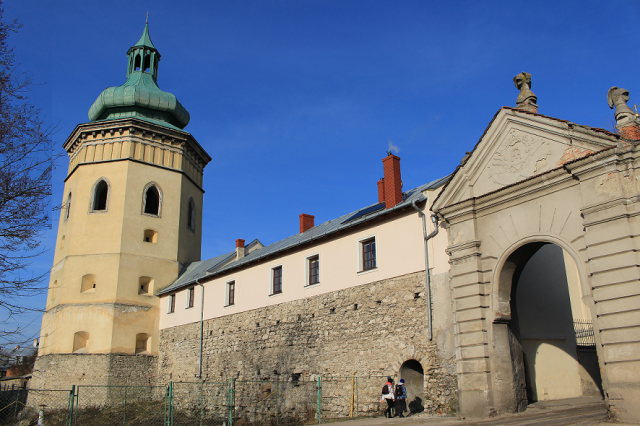
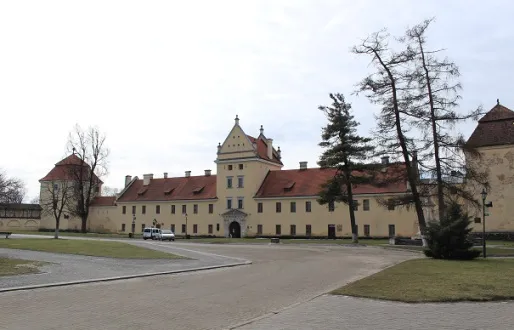
When the Polish-Lithuanian Commonwealth was divided and collapsed, Zhovkva became a territory of the Austrian Empire. After World War I, it became territory of the West Ukrainian People’s Republic and the Polish Republic.
Until 1941, many Ukrainians, Polish, and Jewish people lived in Zhovkva, but when the Soviet army invaded, many Ukrainians were killed. Following this, during the Nazi occupation, many Jewish citizens were either killed or left with no choice but to flee. Historical records of townspeople who helped hide Jewish people during this time are on display in the new city hall’s museum. In the end, there were only 70 Jewish people in Zhovkva who managed to escape persecution. In the 1940s, a fierce war between pro-independence Ukraine and the Soviet army occurred. In particular, on the 22nd of March 1945, forces of the Ukrainian Insurgent Army (UPA) and the Soviet Secret Police (NKVD) battled in the outskirts of Zhovkva, which resulted in a victory for the UPA. However, being hopelessly outnumbered, the independence of Ukraine came to a standstill.
After annexation into the Soviet Union, Zhovkva, which was named after a Polish hero, was renamed Nesterov (Nesteriv in Ukrainian) in 1951, after the Russian hero, Pyotr Nesterov. After Ukraine gained independence, the city returned to using its historical name.
Today, the city has an unbelievable southern charm, and I was under the impression that I had come to a small Italian city (at the same time, it had a similar atmosphere to Polish provincial cities).
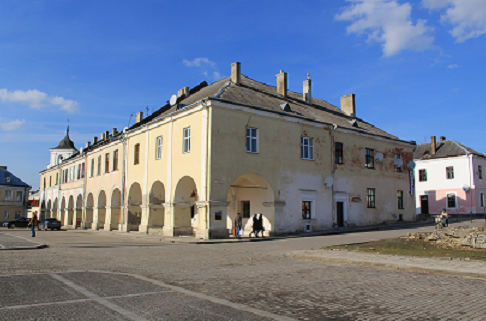
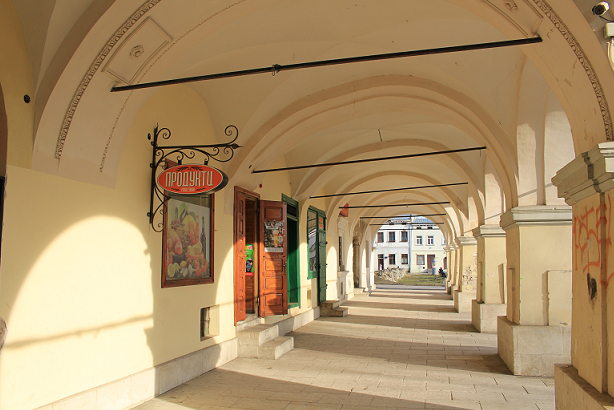
The Zhovkva Castle has been beautifully repaired from the front, but as a result the restoration budget was used up, so the courtyard area and riverside area are still in ruin. Around the end of last year it was reported that there are plans to further restore the castle. This castle, and the new city hall, are now museums. Incidentally, the existence of this new city hall tells the story of how Zhovkva was once a free city, and it can be said that civil society has been developing in Zhovkva since a long time ago. The churches are not very tourist-oriented, so you can only enter them at determined times (displayed on signs) before and after Mass. Also, many churches prohibit photography (although you can often get permission by asking, and I donated money as a thanks for allowing me to take photos).
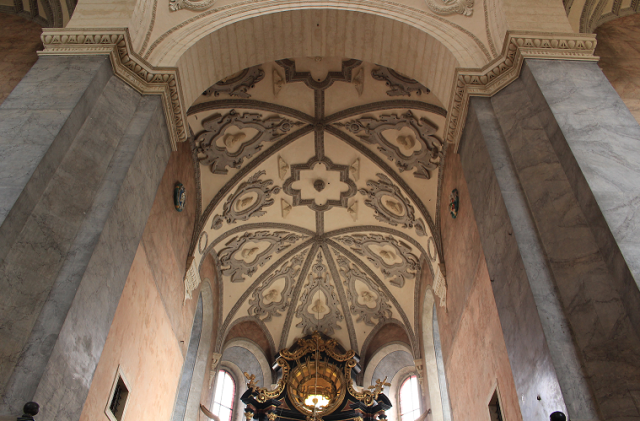
Zhovkva is a Renaissance-style city, but in the chancel of the Roman-Catholic church, the St. Lawrence Church, Mannerism-style decorations can also be seen. Also, the coffin of Żółkiewski is kept in the church’s underground graveyard. At the Church of the Sacred Heart, currently under the jurisdiction of the Ukrainian-Greek Catholic Church, you can see a beautiful stained glass mural made by artist and L’viv Oblast native, Yulian Butsmaniuk. Boasting as the largest structure in Europe, the Synagogue in Zhovkva was built half underground to secure maximum internal space while also controlling the amount of earth.
【Owner of the City】
Stanisław Żółkiewski, who built this city, was a national hero of the once strong European nation, the Polish-Lithuanian Commonwealth, during its Golden Age in the 16th and 17th centuries. Since the ancestors of the Żółkiewski family were Eastern Orthodox, and from an area where many Ruthenians (Ukrainians) lived, it is thought that the Żółkiewskis are of Ruthenian-Polish lineage (in the Commonwealth, race and religion were thought of as the same thing, so it can be assumed that they were Ruthenian since they were Eastern Orthodox). In the early 17th Century, he was known as the magnate who ruled many territories that spread across Ukraine (Ukraine’s Boryspil International Airport was also his territory). I will talk more about Żółkiewski further below.
After the end of the Żółkiewski line, different Ukrainian magnates from the Danylovych and Sobieski families inherited these territories through marital relations. Zhovkva is also known as the hometown of Jan III Sobieski (1629-96), the Polish king famous for fighting in the Battle of Vienna (the Saint Josaphat Church that his brother dedicated himself to is also in Zhovkva).
Stanisław Żółkiewski and Jan III Sobieski are known as the ‘local heroes’ of Zhovkva, but there is also one other name worth mentioning. This is Hetman of the Ukrainian Cossacks, Bohdan Khmelnytskyi (1595-1657), who is regarded as a hero of unknown birthplace in Ukrainian history. It is said that this hero, who is famous for being a key figure in the Ukrainian Independence Movement, was born in Zhovkva. There are various theories regarding the birthplace of Bohdan Khmelnytskyi, but since his father, Mykhailo Khmelnytskyi, was from a clan serving Stanisław Żółkiewski in Zhovkva, and living in Zhovkva during the estimated period of Bohdan’s birth, it can be theorized that Bohdan Khmelnytskyi was born in Zhovkva. Later in life, when Żółkiewski’s daughter married into the house of Ivan Danylovych, Khmelnytskyi also began serving the Danylovych clan, but was granted land in Subotiv as a reward for his long years of service under Żółkiewski (accepting this territory unlawfully is an act of rebellion against the commonwealth, which led to the revolt of Khmelnytskyi in 1648).
【The Heroic Stanisław Żółkiewski】
Stanisław Żółkiewski held all of the important posts of the Kingdom of Poland, such as the Castellan of Lviv, Voivode of Kyiv, and Great Crown Hetman (general) of the Polish Army. Of all the historical incidents he was involved in, the most famous, in Ukrainian history, is probably the Nalyvaiko Uprising (1594-96). In Ukrainian literature, Stanisław Żółkiewski appears as a hero of Ukraine on the side of the government forces, a worthy opponent for Severyn Nalyvaiko. Also, many Ukrainian nobles learnt military strategy under his wing, including Khmelnytskyi and Stefan Khmeletskyi, the latter who is known for appearing in many Ukrainian folk songs. Those studying Polish or Russian history will probably be familiar with the Battle of Klushino in 1610. This is a battle that occurred during a period of Russian history called the ‘Time of Troubles’. The Commonwealth army, led by Żółkiewski, crushed the Moscow-Sweden Alliance forces led by Prince Dmitriy Shuyskiy and Jakob de la Gardie, making the name ‘The Polish-Lithuanian Commonwealth’ known to the whole world. At this time, the cavalry (Hussar) that Żółkiewski used as his main force were known for their unique appearance, namely their shining grey winged armor, and became a symbol of the ‘unmatched Polish cavalry’. The Szar of Moscow, Tsar Vasiliy IV Shuyskiy, was forced to abdicate the throne, and was dragged to Warsaw by Żółkiewski. The Commonwealth army who conquered Moscow became Polish royalty.
Żółkiewski is also known for his heroic death. In 1620, the Commonwealth Army was annihilated in the Battle of Cecora (Ţuţora) by the Ottoman Empire, and as the commander-in-chief, Żółkiewski fought with his sword until the very end, but he fought vainly and died in battle. His head was sent to the Sultan, which was then stuck on the end of a spear and paraded around the streets of the city. Afterwards, a number of paintings of Żółkiewski fighting hard to protect the battle flag all alone were painted.
Żółkiewski’s activities were not limited to the military, as he also carried out cultural activities, and is in fact known as the founder of the Jesuit College in Lviv (the college where many Ukrainian nobles and young Cossacks Bohdan Khmelnytskyi and Prince Yarema Vyshnevetskyi studied Western European learnings). Also in the ‘ideal city’ of Zhovkva that Żółkiewski built, buildings of various religions were constructed by his order in an attempt to achieve this ideal. Essentially, Żółkiewski not only built a Roman Catholic church (St. Lawrence’s Church) for his own religion, but also built places of worship for Eastern Orthodox believers (Church of the Sacred Heart, Monastery of the Nativity) and synagogues for Jewish people. The idea of all these religions existing together harmoniously in one city is the Renaissance city ideal he was aiming for. When you think about it, it’s kind of ironic that he had to spend his life fighting battles against other religious sects.
【How to Get There】
From Lviv you can easily get a bus or train (by the way, on Google Maps, Zhovkva Station is shown with its Soviet era name, Nesteriv-Lvivskyi. In fact, Ukraine is still called ‘The Ukrainian Republic’, its Soviet era name, on Google). I think it takes about an hour to an hour and a half from Lviv station or the central part of Lviv (as it takes about 30 minutes to the central area from the ‘Pivnichnyi’ bus terminal, which is advertised as ’30 minutes to Lviv!’, despite taking 30 minutes just to get on the bus). The bus itself is not that uncomfortable. The train runs until the Rava-Ruska border with Poland, and although it is just a regular train, it has couchette cars, so you can sleep.
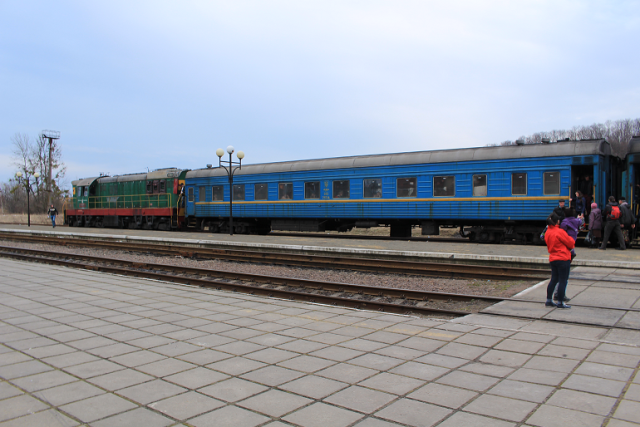
February Activity Report
5 March 2018
Global Japan Office Coordinator
HARA Masaki
【A Confusing Start to the Semester】
Majority of universities in Ukraine this year started their second semester (Ukrainian universities generally follow a two-semester system) later than usual. This is apparently to cut back on indoor heating costs. Even at L’viv University, the second semester didn’t begin until the last week of February. Since this is the time of year when things start cooling down, many people are catching colds.
However, just as the new semester began, an executive order was issued that all educational institutions are to close during the second week of March. This was in response to Russia suspending gas supply to Ukraine, and was designed to prevent energy shortage-related emergencies, such as heating shortages, during the minus 20 degree weather. After this, with the assistance of the EU, enough fuel was secured, schools were reopened and students were informed that classes would go on as normal. However, since it was a weekend, many students had gone back home (there were actually consecutive national holidays in this week anyway), and many universities decided it was too difficult to suddenly start classes again, so many universities stayed closed as per the executive order (although it seems that elementary through high school institutions held classes as per usual). L’viv University was closed without exception.
Ever since the start of Russian military intervention in 2014, Ukraine has suffered chronic energy shortages, and although this situation has improved over time, the lighting is still very dark (while it is not the case now, when I counted before, in each car of an express train only one out of seven lights were lit). Heating is still used at a minimum, and my guess is that the biggest changes are the ones not immediately noticeable to foreigners (for example, the number of operating factories). As a Tokyoite, I can remember a little bit of the situation in the beginning of spring 2011 (obviously I’m not old enough to be able to remember what it was like during the war). The confusion from this semester is a result of this historical context, but I hope one day this can all be solved.
This energy problem is ‘regularized’ every year by the Ukrainian winter, and so I don’t think it causes any serious problems for the TUFS Summer School program in September. I actually want everyone to experience this ‘dark Ukraine’, in moderation of course.
January Activity Report
5 February 2018
Global Japan Office Coordinator
HARA Masaki
【Going on exchange to L’viv University】
Since this month is L’viv University’s winter vacation, I held an information session on exchange opportunities with L’viv University at TUFS. This time, I also want to supply exchange information at L’viv.
A partnership agreement was established between TUFS and L’viv University this academic year, and as a result we have opened some international exchange programs. Each year, one long-term exchange student from L’viv will be sent to TUFS, and one long-term exchange student (if there is an applicant) from TUFS will be sent to L’viv. If there are no applicants for the long-term exchange, TUFS will send 3 short-term (September Short Visit 3 Week Course) exchange students to L’viv. In September 2017, the first three short-term exchange students were sent to L’viv from TUFS. At present, there is one L’viv University student on exchange at TUFS.
【Conditions and Training for International Exchange】
As for the training during the exchange (at L’viv University), the main goal is the acquisition of the Ukrainian language. As a condition, prospective exchange students must learn the Ukrainian alphabet before coming to L’viv. There are no restrictions concerning year level, and of the students who came last year, two were first and second year undergraduate students, and one was a first-years master’s student.
The short-term Ukrainian course, as of September 2017, consists of language training (Ukrainian) in the morning, and academic /cultural lectures (on various topics related to history, literature and linguistics such as Ukrainian cuisine, traditional doll-making and city facilties).
As for accommodation, exchange students at L’viv University are provided with lodgings in the university dormitory free of charge. International and local travel expenses and food expenses are to be dealt with by the individual. The school cafeteria is very inexpensive, and a single meal at a family restaurant generally costs between 300 and 400 yen (although this can change depending on the food and amount).
Also, last year’s exchange students used their weekends to go on small trips to Kiev and Odessa, which they seemed to enjoy very much.
【Getting to Ukraine】
Japanese citizens can visit Ukraine for 90 days without a visa. There are no particular forms that must be filled in to so do.
There are no direct flights to Ukraine from Japan. The route to Ukraine can vary depending on the season, so we advise that prospective exchange students buy their tickets once their exchange has been finalized (please be aware that travelling between the airport and the dormitory can cause difficulties for late-night and early morning arrivals/departures).
【The Current Situation in L’viv】
In terms of public safety, there is currently no cause for concern. The eastern frontlines (Mariupol etc.) are separated from L’viv by 2 days and nights via long-distance express train, and there are no signs of war in L’viv. While some students may be worried and influenced by the terrorist attacks in Western Europe, no attacks of this kind have happened in Ukraine.
Of course, regardless of where you are, it is impossible to predict what will happen, and so one must be more careful than when they are in their own country. However, it is very unlikely that an exchange student would get mixed up in politically-motivated troubles in L’viv.
Back to the public safety situation, and this can be said for all of Ukraine, there are no particular dangers awaiting students. L’viv in particular has always been a safe city, regardless of whether one visits as a student or a tourist. As long as one follows the general rules of travelling abroad, there should be no problems. Also, there are currently no concerns regarding police officers arresting foreigners for monetary bribes, which has been a big problem in the former Eastern Bloc countries. There is also no need to worry about being targeted by racist attacks.
【The School Year】
L’viv University follows the semester system. The first semester is from September until the following January (including the new year break), and the second semester is from February until mid-June (with a self-study period implemented until July).
The vacations each year are generally from January 6th to February 8th, and July 15th to August 31st. However, these dates are subject to change, and in 2018, the Winter break will end on February 25th.
The University is closed during the vacations, and so students cannot enter the campus.
The training period this year will most likely be held from the first Monday of September until the third Friday, but this has not yet been finalized.
Due to educational reform in Ukraine, the academic calendar and curriculum are changing every year, so to anyone thinking of visiting outside of the TUFS Summer School period, it is important to doublecheck the L’viv academic calendar.
December Activity Report
5 January 2018
Global Japan Office Coordinator
HARA Masaki
【Everyday Life at L’viv University】
December was full of frequent snowfall. However, due to the level of humidity, I think this same temperature in Tokyo actually feels colder. Real winter in Ukraine begins after the New Year.
The school year begins in September at L’viv University, and so the first semester classes end in early December. After that, there is the examination period, and then the winter break begins. In Ukraine, there are three types of tests. One type is similar to a pop quiz or a quick test, and is called コントローリナ・ロボータ. Then, in the beginning of December, there are ザーリク, which are tests you can only pass or fail. The third type of test is called イースペィト, and is a standard points-based examination. If a student receives the worst score, they can be expelled (however there are measures in place to help these students such as supplementary examinations). There is no system in place for students to repeat a year. The examinations are not only written, but also oral, which I suppose is a strength of the Ukrainian system when compared to Japan.
In other news, L’viv University is considering delaying the starting date of the second semester to save energy and utilities. This is probably because of the sudden rise in utility expenses due to the reduction of the university budget, inflation, and resource price increase caused by political pressure from neighboring countries. It seems that the next semester will start at the end of February, 2-3 weeks later than usual. However, at this point, I’m still not sure what is happening. To anyone considering visiting L’viv University, please keep this in mind. As a rule, the university is completely closed throughout the winter break, so you can’t enter.
【Kolomyia Japan Event】
On the 11th of December, I went together with Professor Oresta Zaburanna to the city of Kolomyia in the neighboring Ivano-Frankivsk province. The two of us were invited by the Kolomyia Mykhailo Hrushevsky Gymnasium and the Kolomyia Board of Education to give a presentation on Japan and the Japanese department at L’viv University. Just one day before this, Kolomyia celebrated a ‘Japan Day’ (https://www.facebook.com/events/512904105760771/), but since we weren’t called for this event we didn’t participate. People that came to see our presentation told us about it. It seems the day was celebrated by watching Japanese movies, doing origami, and making Japanese food. Both the Japan Day and our presentation were organized by the Japanese embassy in Ukraine as part of the ‘Year of Japan’ project, and it seems that Kolomyia enjoyed two-day Japan experience.
At our presentation, we talked about Japanese schools and education. Afterwards we held a question and answer session, and many participants asked specific and detailed questions on a range of topics, as opposed to the general questions we were expecting. This made me feel that they were very interested in Japan.
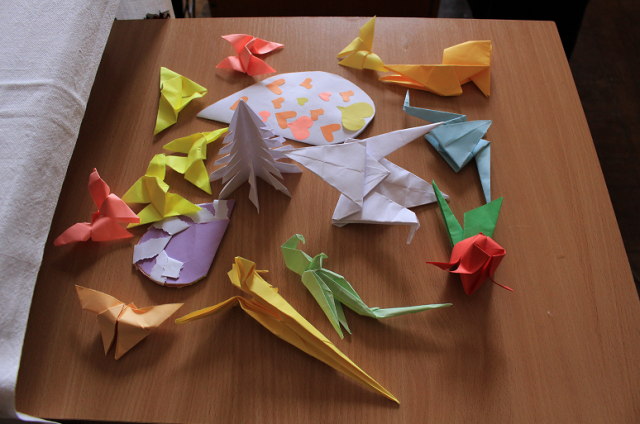
【Kolomyia】
Kolomyia is a city even older than L’viv, and as proof of this historical and cultural standard, Kolomyia calls itself ‘the second biggest city of Western Ukraine’ (even though it is technically the third with a population of 61,018 as of November 1st 2017). The name of the city first appeared in 1241, as Kolomyia was a stronghold built by the Principality of Halych to protect against invasions from Hungary and the south. After that, Kolomyia was ruled by the Kievan Rus’, the Kingdom of Poland, and then the Austro-Hungarian Empire.
The Kolomyia Gymnasium that we visited (http://www.kolgym.if.ua/) was one of the earlier educational institutions in Ukraine to give instruction in Ukrainian, and boasts many famous graduates such as Vasyl Stefanyk (Ukrainian writer, 1871-1936), Petro Franko (son of Ivan Franko, military leader, and educator, 1890-1941), and Dmytro Pavlychko (poet, born 1991, his poem ‘two colors’is featured in the textbook ukurainago nyuumon by Kazuo Nakai, 1991, pp. 112-113). At the gymnasium, we were greeted with traditionally with a violin performance of local music.
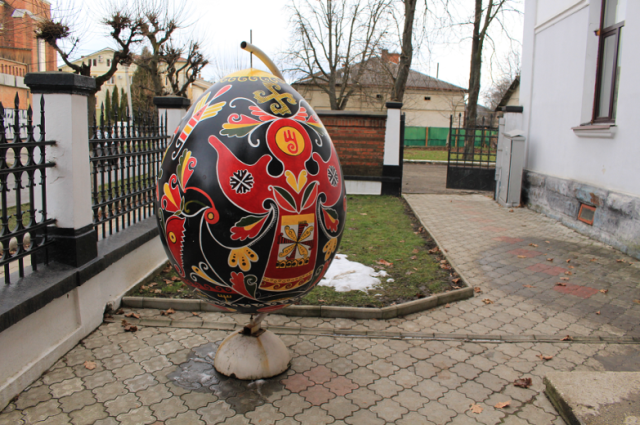
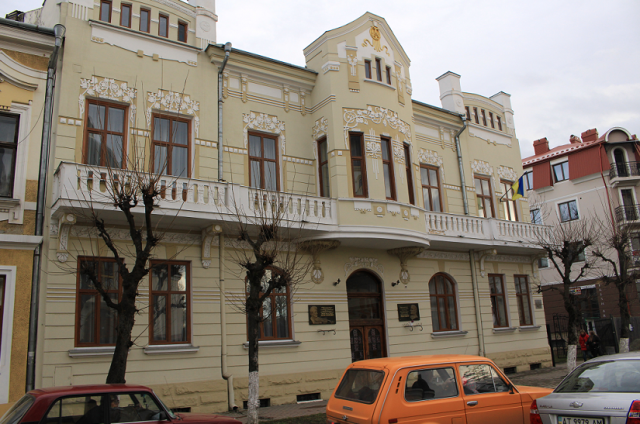
November Activity Report
5 December 2017
Global Japan Office Coordinator
HARA Masaki
【Everyday Life at L’viv University】
At L’viv it has started to snow and has gotten quite cold. Crows and Magpies, undeterred by the snow, play cheerfully among the dead trees, searching for food. The philosopher Bachelard has written many accounts of the romantic flickering flames in the fireplace, but what we have here are only gas stoves, which spit blue flames in fiery eruptions as loud as jet engines, effectively blowing away any trace of contemplation or sentiment that there could have been. I wish the gas stoves could blow away the utility costs in the same way. It is a hard season for animals and plants alike, but it is also a hard time for people. More students than usual are off sick and most of the coordinators have caught colds, but for now they are still on duty, providing class support.
In the sophomore class the other day, we talked with the students about their families. We found out that they all belong to four-person households, and that many of the students’ younger brothers do karate. Karate is apparently quite popular in Ukraine. However none of the students themselves does Karate. It was a strange coincidence- I also belong to a four-person family, and my younger sister has done Karate before, but like the students I myself have never done it. Among the students there was one whose father was a stay-at-home dad, and there was also a student who lived alone with her sister; both having left their hometown in order to further their studies. I was afforded the opportunity to take a glimpse of Ukrainian social trends, and to be exposed to the many different kinds of households found here.
In December the weather becomes increasingly harsh as Ukraine heads deeper into winter, but for the students the true enemy is not the illnesses brought on by the cold, but the exams they face. Several students do not look well. The onslaught of exams begins with the Japanese Language Proficiency Test in early December and is followed by a multitude of regular university exams at the end of the semester. November was the last regular month before exams.
October Activity Report
5 November 2017
Global Japan Office Coordinator
HARA Masaki
【Everyday Life at L’viv University】
As for L’viv University students, you could say that this month was generally occupied by classes on a daily basis.
Students majoring in Japanese here at L’viv University take many classes every day. I’ve been told that majority of these are compulsory subjects, with few elective subjects on offer. The class schedule is made up of eight periods, and so classes start at 08:30, and finish at 21:00. The Japanese major students not only have to take Japanese Language and Japanese Literature, but must also take subjects that are compulsory for all literature department students, such as Ukrainian. This is so students learn about their own country, instead of only focusing on some far away foreign land.
For each year-group there is a Dean, and a lot of the time this Dean is also in charge of the Japanese classes. Aside from that there are also a few classes on Japanese literature, teaching methods, and history (despite the literature, history, and philosophy departments being separate departments). When there is a native Japanese speaker in the class, the students always want to practice their conversation skills. However, it’s not very good to waste class time on conversation alone, so I focus on supporting them with writing and reading skills. I think they will pick up conversation skills through this anyway.
The one thing that causes the students stress is, of course, exams. The examination period in Ukraine is very long, lasting for about one month. Many of the exams are oral, in other words interviews, which sometimes last from morning to evening.
It may seem like a very intense student life, but the students who study seriously always become able to communicate in Japanese fairly well. I think TUFS students should learn from this example. There are many students who come from the suburbs of L’viv (up to three hours away by train), or from faraway towns, and so many of these students return home during the weekend. This means that the middle-distance evening trains are often bustling with students on the weekends. Students who come from towns over 20 hours away can usually only return home during the longer vacations. I think there are many people in Ukraine who put their family first.
【Japanese Speech Competition】
While this month was a fairly normal one, there was one big event for the students of the Japanese department. This event was the ‘Japanese Speech Competition.’ Last year was the first year the competition was held locally, here at L’viv University, but this year the event returned to being held in the capital of Ukraine, Kyiv. Two students from L’viv University, Iryna Maksymets and Anastasiya Luhova, participated in the competition.
We practiced and rehearsed many times for this day, but the students’ pronunciation during the practices was in a condition where the coordinators couldn’t understand what was being said, and so I deeply felt how difficult Japanese intonation is.
According to Professor Olya, both of the students did well in their speeches and Q&A sessions, but when I asked the students themselves they were very critical of themselves.
Furthermore, just before this competition there was a major incident after a car chase in Kharkiv, a city in eastern Ukraine. In a truly tragic turn of events, a car sped onto the sidewalk, causing many casualties. Among the deceased was a parent and child on their way to participate in the ‘Japanese Speech Competition.’ My deepest condolences go to the affected families.
September Activity Report
5 October 2017
Global Japan Office Coordinator
HARA Masaki
【Global Japan Office Opens at L’viv University!】
This month, the 13th Global Japan Office was established here at the Ivan Franko National University of L’viv. The opening ceremony was held on the 14th of September 2017, and attended by Professor Emiko Hayatsu, Professor Izumi Maeda, and Professor Chiho Fukushima from TUFS, and many students and faculty from L’viv University including the Vice-rector, Mariya Zubrytska, the Dean of the Faculty of Philology, Svyatoslav Pylypchuk, and the acting head of Oriental Studies, Oresta Zaburanna. Three exchange students from TUFS, and other guests were also in attendance.
Also, since this year marks the 100th anniversary of Ukrainian Independence, and is also the 25th anniversary of Japan-Ukraine relations, the Japanese embassy in Ukraine has organised a ‘Year of Japan.’ This ceremony was recognised by the ‘Year of Japan’ project.
Before the opening ceremony, Professor Hayatsu held a commemorative lecture titled ‘The Meaning of Words and their Grammatical Properties: Lexical Meaning, Grammatical Meaning, and Categorical Meaning.’ Ranging from 2nd year undergraduate students to master’s students, many students from the Japanese department attended the lecture. This lecture was a valuable experience for L’viv University students, as they were able to take a class in Japanese, and usually have little opportunity to learn from and talk with Japanese specialists. The students seemed to be very excited to experience something different in the classrooms they always learn in.
At the ceremony, two Master’s students from the Japanese department acted as presenters. Both of the students wore traditional vyshyvanka especially for the event. There was also a wonderful violin performance by another Master’s student (who was also wearing a vyshyvanka). He played Michio Miyagi’s ‘The Sea in Spring.’ Congratulatory addresses were given by Professor Hayatsu, Professor Zubrytska, and Professor Pylypchuk. According to Professor Zubrytska, opening a new office in L’viv University, the oldest university in Ukraine, is a very significant thing. (L’viv University was founded in 1661 after the signing of the Treaty of Hadiach between Ukraine and the Polish-Lithuanian Commonwealth in 1658. While there are other educational institutions with longer histories such as Ostroh Academy and the Kyiv-Mohla Academy, L’viv University is the oldest university that has been operating continuously).
After exchanging gifts, the students surprised everyone by performing the TUFS school song. We secretly practiced this with the L’viv University students especially for this day! The students were a little nervous, but I think the teachers from TUFS were very pleased. One of the students played the accompaniment on violin, making it a unique version of the song that perhaps cannot be heard elsewhere, even in Asahi-cho. After this, everyone sang L’viv University’s school song, ‘Gaudeamus,’ and the ceremony came to an end.
More information on this opening ceremony can be found on the TUFS homepage, (https://www.tufs.ac.jp/english/2017/10/tufs-171016ukrainegjo.html), and also on the L’viv University official website(http://www.lnu.edu.ua/en/a-representation-of-the-tokyo-university-of-foreign-studies-was-opened-at-lviv-university/, http://www.lnu.edu.ua/gallery/u-lvivskomu-universyteti-vidkryly-predstavnytstvo-tokijskoho-universytetu-inozemnyh-mov/). The GJO office has been established in a classroom managed by the Ya. Dashkevych Department of Oriental Studies. Because of this, Japanese classes are also held in the office, giving it more of a classroom feel than an office vibe.
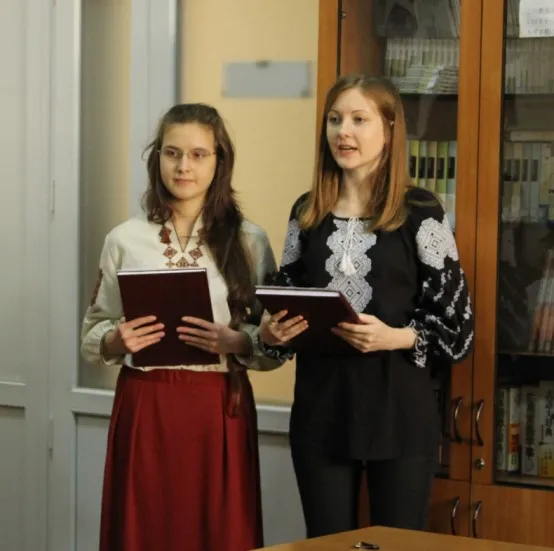
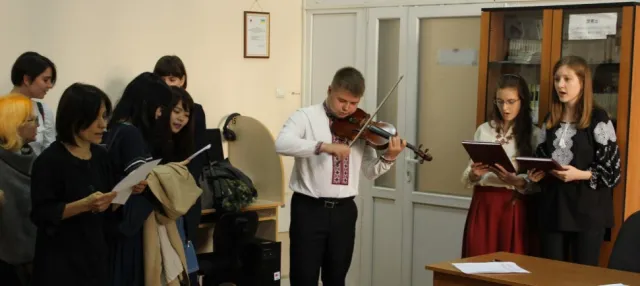
【Exchange Students From TUFS Have Arrived!】
Another important thing that happened this month was the arrival of the first exchange students from TUFS. These students are Yuko Ii, who is currently working hard on her Master’s thesis, Rina Sugama, a second year undergraduate student studying Russian, and Haruna Tanaka, a first year student also studying Russian. The students all came to L’viv for different reasons, but I think they were able to make the most of the three weeks they spent here. The teachers of L’viv University and a few volunteers helped us think of what to do with the students, and as a result the students were able to not only take Ukrainian classes, but also participate in culture and history lectures, Ukrainian doll-making (motanka) and Borscht (Ukrainian soup) master classes, and an event at the Centre for Culture and Creativity for Children and Youth in Halychyna. Students from Lviv University also showed the TUFS students around the city.
The exchange came to an end in the blink of an eye, so the exchange students and visiting teachers returned home, making L’viv lonely again. Incidentally, and no doubt thanks to this series of events, the Japanese population of L’viv experienced the rarest fluctuation in history during mid-September. Now that I think about it, it may have been a good idea to go to L’viv’s Yaponska Street (Japan Street) with everyone (this street was named to commemorate Japan’s victory in the Russo-Japanese War).
【Book Market】
From the 13th-17th of September, the 24th Annual Publisher’s Forum was held at the Potocki Palace and the L’viv Art Palace (http://bookforum.ua/). Exhibits were held by publishing companies big and small from all over Ukraine, and from neighboring countries Belarus and Poland. Students and teachers from TUFS attended the exhibition, and acquired some interesting books. At this event, not only could you find books that are usually hard to get in L’viv, but you could also buy books at a much lower price than usual, so book-lovers left with mountains of books tucked under each of their arms. Even if you don’t buy much, seeing that many new books all written in Ukrainian is a truly moving experience. If you ever come to L’viv around this time of the year, I think it is worth taking a look.
